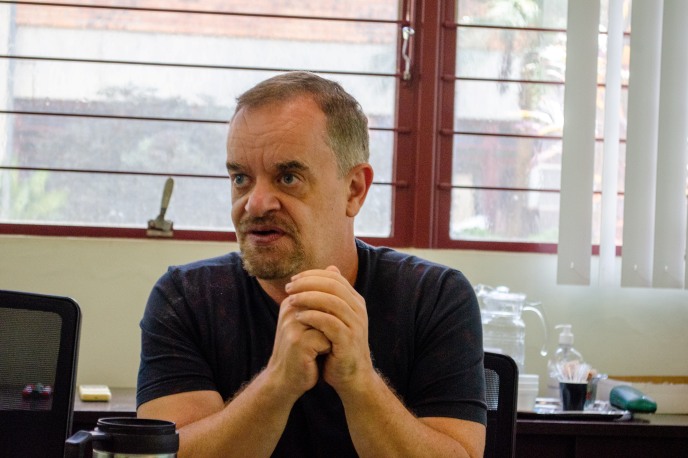
Bruno Leal, from the Department of Communications at UFMG.
Photo: Yan Marques – IEAT/UFMG
Professor Bruno Souza Leal, from the Department of Social Communication at the Faculty of Philosophy and Human Sciences at UFMG, presented his residency research during the third meeting of the IEAT Residents Exhibition, held on May 7, 2025.
Bruno Leal spoke on the topic of Everyday Catastrophes: Analytical Explorations of the Connections Between Textualities, Events and Temporalities. He began his speech by highlighting the development of the field of communication worldwide, with particular emphasis on the Brazilian context. According to him, in Brazil, social communication, as an academic field, emerged historically linked to the idea of national modernization. Undergraduate education, from the very first courses, was linked to the idea of training professionals capable of working in a growing job market, due to the advancement of the cultural industry in the country.
According to him, the project to create national communication networks, which is based on a hyper-centralized communication model, was born in the 1960s and 70s on a foundation with strong political and economic appeal. “These two factors are important to understand the communication scenario in Brazil, the emergence of large radio and television oligopolies and their role in the country’s history. However, the idea that the [mass] media could exert great influence on the population’s opinion, acting as a fourth power, is gradually losing strength, especially in the context of the so-called new media,” he highlighted.
Moving forward in his presentation, Bruno Leal highlighted the idea of the broadening of the concept of media itself, which is modified. With the development of new theoretical currents of communication, the concept of media evolved to designate any support, technology or device capable of materially enabling the circulation of signs in a given communication process. Thus, different objects and technologies can be understood as media, to the extent that they are integrated into a given communication process.
In the final part of his presentation, Bruno Leal highlighted the notions of interaction, mediation and experience, which are commonly taken as dimensions for thinking about the production of meaning in contemporary communication processes. For him, it is necessary to think about communication from the perspective of experience, with all its gaps and contradictions.
From the perspective of experience, Bruno Leal explained that he seeks to understand certain problematic events and realities that are naturalized in everyday life, such as everyday catastrophes, which are the subject of his research. He explained that, after overcoming the initial challenges of theoretical and methodological articulation, his research has unfolded around three axes: catastrophes that occur through everyday experience, especially urban disasters, environmental disasters and violence against women.
Bruno Leal explained that the research aims to understand the experience of everyday catastrophes as an interpolation of meanings, based on the idea of social heterogeneity, forces, powers and temporalities that permeate and emerge from them. The aim is not to understand the event as a constitutive element of a specific isolated reality, but to understand a given event or situation as articulated with others. Events are interconnected and incorporated into each other. It is with this in mind that Bruno Leal presented several images to exemplify what he called the naturalization of everyday catastrophes, such as photos of magazine stands, memes that circulated during the COVID-19 pandemic, images of landfills and people struggling with the consequences of tailings dam collapses. These images materialize as if they were temporal threads that bring together past, present and future and a search for reinvention in challenging situations or scenarios, in an increasingly digitalized world.
Finally, Bruno Leal also considered the research as a critical movement: it involves looking at these events as a questioning of the journalistic event itself. “The research arises from a critique of traditional journalism itself and the idea of the newsworthiness criteria of a given fact, because it is not about showing something that is exceptional, but indicating the place of the ordinary and the everyday in the very constitution of human life,” he concluded.